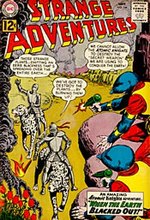The original Atomic Knights

The Atomic Knights appeared in every third issue of Strange Adventures in the early 1960s, beginning with #117 (June 1960) and running through #160 (January 1964). [3] In all there were 15 early-1960s Atomic Knights stories created by writer John Broome and artist Murphy Anderson; they were a band of heroes living in and protecting the post-apocalyptic future of 1992.
Following the catastrophic Hydrogen War of 1986, a petty tyrant named the Black Baron ruled a small section of the Midwestern United States with an iron fist. He was opposed by Sgt. Gardner Grayle and the Atomic Knights, who wore energy-resistant armor. [4] The other Knights were twins Wayne and Hollis Hobard, Bryndon Smith, the last scientist left on Earth, and brother and sister Douglas and Marene Herald. The group became a symbol of hope to the survivors of the cataclysm. [5]

The 15 Atomic Knights stories in Strange Adventures took place in "real time" (three months usually passed between the events of each story as well as in the real world) and generally dealt with post-holocaust recovery, as the Knights would fend off menaces and attempt to rebuild the area around their home base of Durvale, though they also managed to travel to Los Angeles, Detroit, New Orleans, New York, and Washington, D.C.
The Atomic Knights concept then laid dormant for more than a decade, until Cary Bates used the Knights as guest-stars in the mid-1970s series Hercules Unbound , beginning with #10 (April–May 1977). It was then revealed that Hercules, Kamandi, and the Atomic Knights all inhabited the same comics universe. Crisis on Infinite Earths: Absolute Edition had two Great Disaster realities: Earth-86 (where the Great Disaster that led to Kamandi's future was an atomic war) and Earth-295 (where the Great Disaster was natural). Since the Great Disaster on Earth-295 was natural, that reality had no Atomic Knights.
The Great Disaster has since been declared to be out-of-continuity in the current DC Universe, although one of the Post-52 alternate Earths (Earth-17) does feature the world of the Great Disaster. DC Comics Presents #57 attempted to retcon the Atomic Knights by 'revealing' them to be the dream of Gardner Grayle in a state of suspended animation (during which dream Superman attempts to prevent Grayle from causing a nuclear war). This story is not held to be canon in terms of the Earth of the Great Disaster, and little reference has been made to it after publication.
The 15 Atomic Knights stories were reprinted in Strange Adventures #217-231. In 2010 they were collected into a single DC hardcover volume; their appearances in Hercules Unbound and DC Comics Presents had not been reprinted until a 2014 volume entitled Showcase Presents The Great Disaster Featuring the Atomic Knights.


